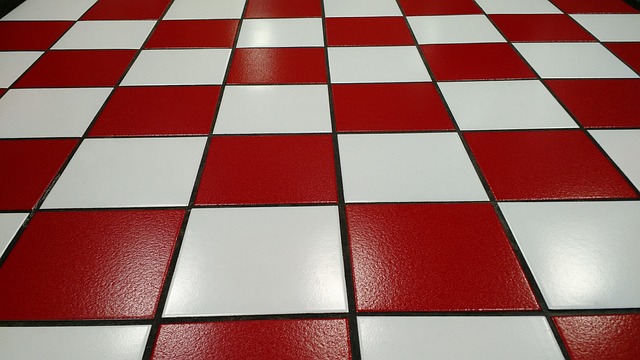Grout lines, despite their functional and aesthetic value, are prone to staining due to porosity and depth. Prompt stain removal is crucial using mild detergents or enzyme-based grout cleaners. Regular cleaning, sealing, and testing products on inconspicuous spots prevent future stains. Frequent vacuuming and mopping minimize dirt and moisture that cause grout line discolouration, emphasizing the importance of regular maintenance for effective stain prevention and removal.
Grout lines, those delicate crevices between tiles, add definition to your flooring but can also become hotspots for staining. Understanding how stains develop and implementing proactive measures is key to maintaining a pristine home. This guide delves into the science behind stained grout, exploring common culprits, effective pre-treatment strategies, and powerful stain removal techniques. We’ll also equip you with knowledge on choosing the right cleaning products and offer maintenance tips to prevent future discoloration, ensuring your grout lines stay sparkling clean.
Understanding Grout Lines and Their Susceptibility to Stains

Grout lines, those narrow channels between tiles in floors and walls, serve both functional and aesthetic purposes. However, their linear nature makes them particularly susceptible to stains. This is due to several factors. Firstly, grout lines are often deeper than surrounding tile surfaces, capturing dirt, debris, and moisture that can lead to staining. Secondly, the porous nature of grout allows substances like oil, wine, or coffee to penetrate and set, making removal more challenging. Regular cleaning and sealing are crucial for maintaining grout lines, especially in high-traffic areas or kitchens and bathrooms where stains are common. Understanding these vulnerabilities is the first step in developing an effective stain treatment strategy for grout lines. Knowing how to remove stains from grout lines promptly can help preserve their visual appeal and prolong the life of your flooring or tiling.
Common Causes of Staining in Grout

Stains in grout lines are a common issue that many homeowners face due to several factors contributing to their appearance. The most prevalent causes include water damage and moisture intrusion, which can lead to mold and mildew growth, causing discoloration. These microscopic organisms thrive in dark, damp environments, often found within the narrow gaps of grout. Another significant factor is the type of cleaning products used; harsh chemicals may strip away the protective sealants, leaving grout lines vulnerable to staining.
Additionally, dirt, grease, and grime from everyday foot traffic accumulate in these crevices, especially in high-traffic areas like kitchens and bathrooms. Spills from beverages, food, or cosmetics can quickly set and harden, making them difficult to remove without proper care. Over time, improper cleaning methods or using subpar grout cleaners can also contribute to the formation of stains, emphasizing the need for effective stain removal techniques.
Pre-Treatment: Preparing Your Grout Lines for Cleaning

Before diving into the actual stain treatment process, proper preparation is key to achieving optimal results when removing stains from grout lines. Start by sweeping or vacuuming the floor to eliminate any loose debris that might interfere with cleaning. Next, address any existing grime or buildup using a mild detergent and warm water solution. Scrubbing gently with a soft-bristled brush can help loosen stubborn particles without damaging the grout material. Rinse thoroughly to ensure no residue remains, as this pre-treatment step sets the foundation for effective stain removal.
Additionally, testing a small, inconspicuous area is essential to determine the best cleaning method and product compatibility. Apply a tiny amount of chosen cleaner to a hidden spot, wait the recommended time, then assess its impact. This ensures you understand how the grout lines will respond, enabling you to make informed decisions when treating larger areas and preventing potential damage or discoloration.
Effective Stain Removal Techniques for Grout

Removing stains from grout lines can be a challenging task, but with the right techniques, it’s achievable. Start by identifying the type of stain and choosing an appropriate cleaning solution. Standard household cleaners like baking soda, vinegar, or hydrogen peroxide work well for mild stains. For tougher cases, consider using specialized grout cleaners that contain enzymes to break down dirt, mold, and mildew. These products are effective in removing organic stains and can restore the grout’s original color.
When applying any cleaning solution, always test it in a small, discreet area first to ensure it won’t cause discoloration or damage. For stubborn stains, a mixture of warm water and mild detergent can be used as a last resort. Scrub the grout lines gently with a soft-bristled brush or an old toothbrush, then rinse thoroughly. Regular cleaning and sealing of grout lines are key to preventing future staining, ensuring your grout stays looking fresh and clean.
Choosing the Right Cleaning Products for Optimal Results

When it comes to removing stains from grout lines, selecting the appropriate cleaning products is paramount for achieving optimal results. Not all cleaners are created equal; some may even cause further damage or discolouration. It’s crucial to opt for solutions specifically designed for tile and grout, which can effectively penetrate and dissolve stubborn stain particles. Look for products that feature active ingredients like oxygen-based bleaches or enzyme-based formulas, known for their gentle yet powerful cleaning abilities. These options are less likely to harm the grout material while still offering excellent stain removal.
Additionally, considering the nature of the stain is key. For organic stains like coffee or ink, enzymatic cleaners or hydrogen peroxide can be effective. In contrast, for mineral deposits or hard water stains, a mixture of warm water and vinegar or a dedicated stone and tile cleaner might be more suitable. Always read product labels to understand their application instructions and safety precautions, ensuring you use them correctly to maximise their effectiveness in removing stains from grout lines.
Maintenance Tips to Prevent Future Staining

Regular maintenance is key to preventing grout lines from staining again. Start by regularly cleaning your grout with a soft brush and a mixture of warm water and mild soap. This removes any dirt or debris that could cause stains. Additionally, sealing the grout after cleaning can create a protective barrier against future discoloration. Use a high-quality grout sealer specifically designed for this purpose, and reapply it every few years or as recommended by the manufacturer.
Another effective strategy to remove stains from grout lines is to act quickly. As soon as you notice a stain, address it promptly using a suitable grout cleaner or stain remover. Avoid allowing stains to set, as this can make them harder to eliminate. Regular vacuuming and mopping of floors can also help prevent staining by removing loose dirt and moisture that could lead to discoloration in the grout lines.
